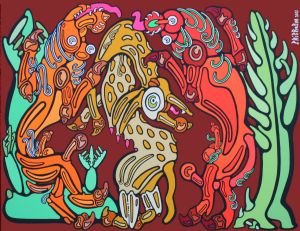| |

|

|
M147 - Two Minoan lions chasing a wild goat .2011.
Painting Acrylic
Size: 38,1 x 49,2 inches
8000 USD
Description:
MINOEN / Translated from French / The origin of this picture is in the spirit of the Mycenaean tradition. It is inspired by an oval agate seal discovered in a tomb in the city of Chania in Crete, identified with the ancient Minoan city of Kydonia on the hill of Kastelli where a theater was demolished today. This necropolis discovered in 1895, when the Late Minoan III, from 1400 to 1200 BC. Remember the place that held the lion in ancient times. The lion refers to the sun by the colors of its fur and because they live in hot countries. More importantly, it represents strength and power. Among wild animals, the lion holds in the imagination of ancient times and particularly the pre-Hellenic Crete and the ancient Near East a special place, a symbol of the chaotic forces of the world, it is considered the king of beasts. As such, it is often associated with human monarchs, and to certain deities. At once fascinating and frightening, the lion was also an apotropaic function. Indeed lions clay, metal or stone often ensure the gates of cities, temples and palaces (Lion Gate at Mycenae), and they are supposed to protect against external enemies and harmful influences. Homer (circa 850 BC.), The lion describes the attitude of the warrior in combat, he expresses the courage and honor, this beast, which vies with the man on his own ground feeder cattle, is both symbolic model and double full hero! According to Pliny the Elder (23-79 AD). This animal is full of good feelings, "the lion is the only beast who shows mercy to suppliants, and he saves those he overpowered his fury exerted on men rather than women, and attacking children in case of famine. Libya is believed that he understood the prayers and in any case I heard back from Gaetulia a captive in North Africa, saying she was in the woods, stopped the assault many Lions, daring talk to them and tell them she was a woman, fugitive, sick, a suppliant at the feet of the noblest of all animals, he was their king at all, and thus, it was unworthy of a prey his glory. " Plutarch (circa 50-125 AD.), in his treatise entitled "love of offspring," notes that philosophers often refer to the animal kingdom. He added: "They appeal to the nature of irrational animals as in a strange city and, to judge, they do not relate to their passions and their manners in the idea that they are honest and incorruptible." This remark could apply to Plutarch himself and especially, dialogue that is titled "The animals were deprived of due use of reason." It was also every reason to doubt that humanity is in the same case? What do you think? Before discussing the table again as we are concerned, we note that the word lion comes from the Latin, "leo" and Greek "leon", but considering that the word is foreign, without we know its origin. The names Leo, Leon, Leonard, Leonie ... are derived. The lions were widespread across parts of southern Europe, we know they were smaller than those in Africa, and therefore it counts also for Greece, Crete and South Italy. Conclude with a stylized to the extreme of our canvas: Two lions flank a wild goat Minoan they are about to devour. It must be very crétophile (what I am!) to recognize instantly the two lions. To the wild goat, the exercise is more difficult unless you know that Mycenae, it was found a fragment wild sheep with slender legs, body spotted line and hail in a bent position (Furtwängler and Loeschcke, Mykenische Vasen, No. 408, Post-Minoan. See: Animals in the paintings of pre-Hellenic Crete, 1926.)
|
|

|
|